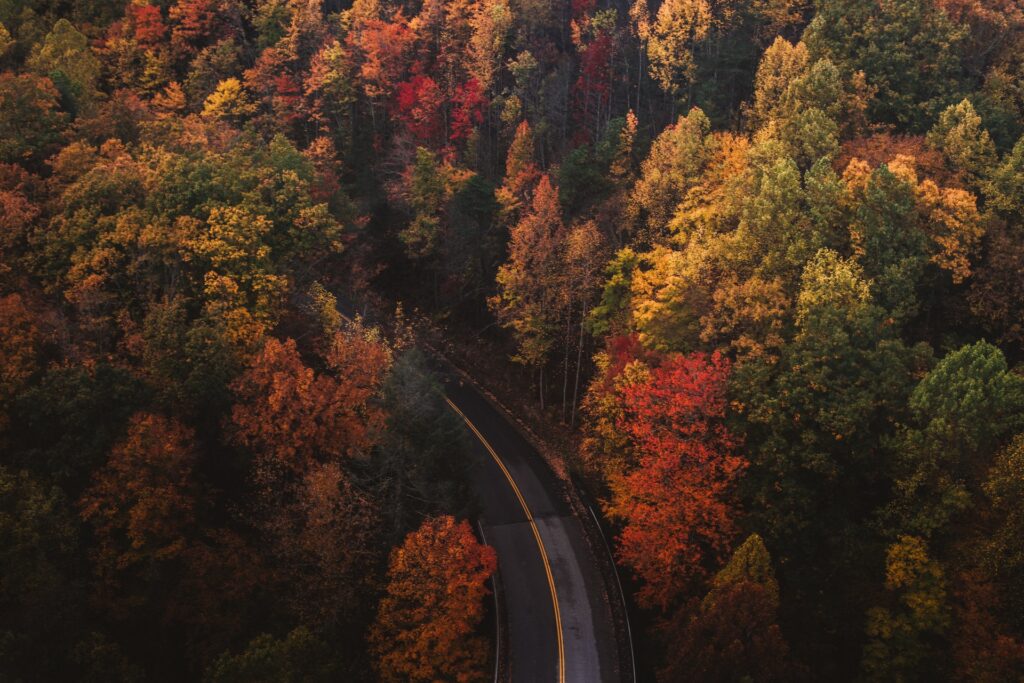As the leaves begin their enchanting transformation from lush green to a palette of fiery reds, brilliant oranges, and deep golds, nature enthusiasts and photographers gear up for one of the most captivating seasons of the year. With its magical fall foliage display, Autumn is a photographer’s paradise, offering a brief but breathtaking window of opportunity to capture the beauty of change.
In this article, we embark on a journey into the heart of fall, where every leaf has a story, and each landscape becomes a canvas painted with the most vibrant and transient hues. We’ll unveil the secrets of “Photographing the Beautiful Fall Foliage Colors Changing,” guiding you through the art and science of capturing this spectacular transformation through your camera’s lens.
Whether you’re an amateur photographer seeking to improve your skills or a seasoned pro looking to make your autumn shots stand out, this article is your guide to embracing the beauty of fall foliage. We’ll walk you through essential gear, share tips on composition and lighting, explore creativity in your shots, and even dive into post-processing to make your fall foliage photos truly pop.
The Magic of Fall Foliage
The onset of autumn heralds a magical transformation in our natural surroundings. As the days grow shorter and temperatures drop, trees shed their vibrant greenery and don a mesmerizing array of warm, earthy tones. The enchanting symphony of reds, oranges, and golds is a spectacle to behold, and it beckons photographers to capture the fleeting beauty of the season. In this section, we’ll delve into the wonder of fall foliage, exploring its visual spectacle, the significance of capturing these colors, and why it’s considered the best season for photography.
Exploring the Visual Spectacle of Autumn
Autumn is a season of transition, a time when the world transforms into a canvas of vibrant hues. The lush greens of summer give way to the fiery reds of maple leaves, the golden brilliance of oak trees, and the warm, russet shades of beeches. Each tree species adds its unique signature to this visual symphony, creating a mesmerizing patchwork of colors that stretches as far as the eye can see.
The transformation is not limited to trees alone. As the leaves fall gently to the ground, they create a tapestry underfoot, forming crunchy carpets of color that invite exploration. The play of light and shadow on this natural carpet is a photographer’s dream, casting an ethereal glow on the landscape.
The beauty of fall foliage doesn’t end with the leaves. The cooler air brings forth misty mornings and hazy afternoons, adding a layer of mystique to your photographs. Sunsets take on a warm, golden hue, casting long, dramatic shadows that enhance the season’s enchantment.
The Significance of Capturing Fall Colors
The significance of capturing the vivid hues of fall foliage lies in creating beautiful images and preserving a moment in time. The colors of autumn are, by nature, transient. They bloom and fade in weeks, making it all the more important to seize the moment and preserve it through photography.
For many, fall foliage holds deep sentimental value. It’s a season of family gatherings, cozy firesides, and long walks through the woods. Capturing these colors in photographs allows us to revisit these moments, evoking a sense of nostalgia and warmth, even when winter has arrived, and the leaves are long gone.
Photographs of fall foliage also connect to nature’s life cycle and change. They remind us of the beauty and impermanence of the world around us. Photographing fall colors is a celebration of the seasons and a testament to the resilience of nature.
Why It’s the Best Season for Photography
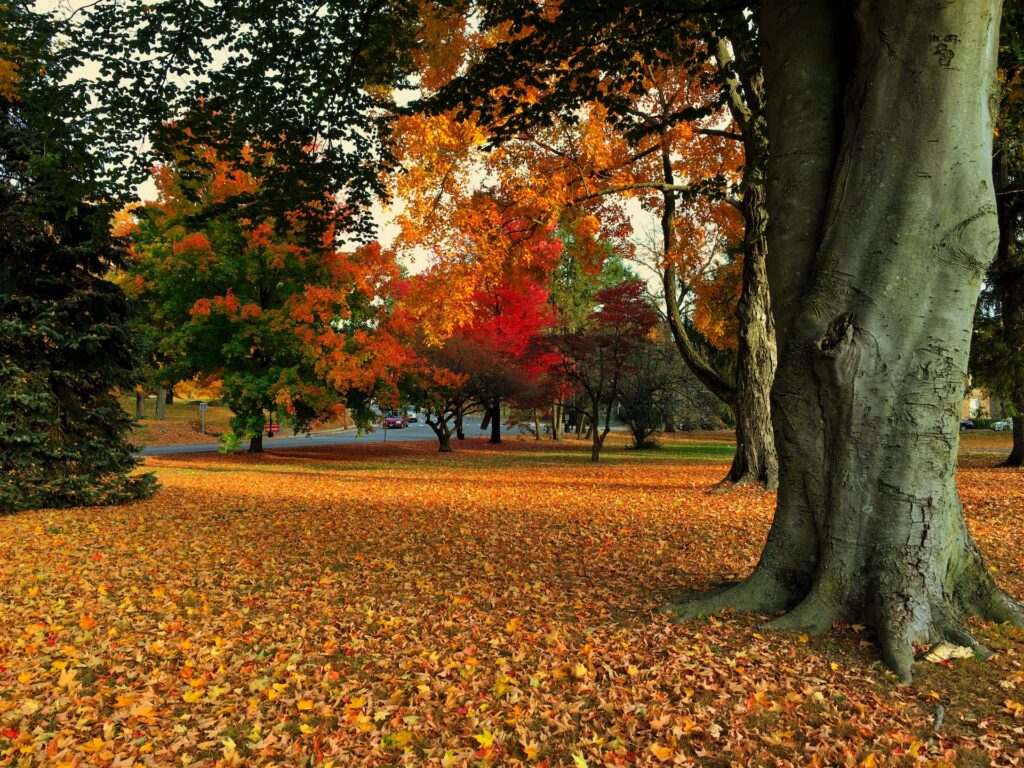
So, what makes autumn the best season for photography? The reasons are as abundant as the fall colors themselves. Here are a few key factors that make it a photographer’s dream:
1. Variety of Colors: The sheer diversity of colors on display in the fall is unparalleled. The range of hues provides endless opportunities for creative compositions, from fiery reds to deep purples, from golden yellows to rich browns.
2. Stunning Backdrops: The landscape transforms into a vivid and textured backdrop, adding depth and drama to your photos. Whether you’re shooting portraits, landscapes, or macro shots, the beauty of autumn foliage elevates your subject matter.
3. Soft, Warm Lighting: The sun’s lower angle during autumn bathes everything in soft, warm light. It creates a flattering, golden glow that’s particularly appealing for photography.
4. Unique Atmosphere: The crisp air, the earthy scent of fallen leaves, and the gentle rustling of trees create a unique atmosphere unmatched in any other season. This atmosphere adds an extra layer of depth to your photographs.
Essential Gear for Fall Foliage Photography
Capturing the breathtaking beauty of fall foliage is a rewarding endeavor, but it requires the right gear to do justice to nature’s vibrant palette. This section will explore the essential equipment to help you maximize your fall foliage photography experience. From choosing the right camera to selecting lenses that enhance autumn landscapes and understanding the importance of tripods, filters, and other accessories, we’ll guide you through the tools you need to create stunning autumn images.
Choosing the Right Camera for the Job
Regarding fall foliage photography, the choice of camera can significantly impact the quality of your images. While many photographers use DSLR cameras, the truth is that you can achieve fantastic results with various camera types, including mirrorless cameras and even high-end smartphones.
Key considerations when choosing the right camera for fall foliage photography include:
- Image Sensor: Cameras with larger image sensors perform better in low light conditions and offer higher image quality. Full-frame or APS-C sensors are good choices.
- Megapixels: A higher megapixel count allows for more detailed and larger prints. However, don’t be overly concerned with this factor; even moderate-megapixel cameras can produce stunning images.
- Weather Resistance: Fall weather can be unpredictable, and it’s wise to choose a camera that’s at least somewhat weather-sealed to protect against rain and moisture.
- Ergonomics: Consider the camera’s feel in your hands. You’ll spend time in the field, so a comfortable, user-friendly camera is essential.
- Battery Life: Fall foliage photography often involves long hikes or hours outdoors. A camera with good battery life ensures you won’t miss out on that perfect shot.
Ultimately, the right camera is the one you are most comfortable using, which aligns with your specific photography needs and budget.
Lenses That Enhance Autumn Landscapes
The choice of lenses can significantly influence the outcome of your fall foliage images. Here are some lens considerations for capturing the beauty of autumn:
- Wide-Angle Lenses: Wide-angle lenses (typically 10-24mm) are ideal for capturing the expansive landscapes and vivid colors of fall foliage. They help you take in the whole scene and make the colors pop.
- Prime Lenses: Prime lenses with wide apertures (e.g., f/1.4 or f/1.8) are excellent for achieving a beautiful background blur, known as bokeh. These lenses can make individual leaves or subjects stand out against a soft, dreamy background.
- Zoom Lenses: Zoom lenses, especially in the 70-200mm range, are versatile for capturing distant foliage or isolating specific scene areas.
- Macro Lenses: If you’re keen on photographing close-ups of individual leaves, a macro lens is a fantastic choice. They allow you to capture intricate details and vibrant colors.
- Telephoto Lenses: A telephoto lens is valuable for more distant shots or capturing the interplay between foliage and the landscape.
The choice of lenses depends on your photography style and objectives. A versatile approach often involves carrying a range of lenses to adapt to different scenarios during your fall foliage expedition.
Tripods, Filters, and Other Useful Accessories
Fall foliage photography often requires stability and creativity in equal measure. Here’s a look at some essential accessories that can elevate your autumn shots:
- Tripod: A sturdy tripod is indispensable for capturing long exposures, reducing camera shake, and ensuring the sharpness of your images. It’s especially useful for sunrise or sunset shots.
- Polarizing Filter: A polarizing filter reduces glare and enhances color saturation, making it an excellent tool for capturing the vivid hues of fall foliage.
- Neutral Density (ND) Filter: ND filters are useful when you want to slow down the shutter speed to capture the movement of leaves in the wind or create long-exposure effects.
- Remote Shutter Release: This accessory allows you to take photos without touching the camera, minimizing the risk of camera shake.
- Lens Hood: A lens hood helps prevent lens flare caused by unwanted light hitting the front element of your lens.
- Extra Batteries and Memory Cards: Fall foliage photography can be time-consuming, and having spare batteries and memory cards is essential to ensure you get all the valuable shots.
By carefully selecting the right camera, lenses, and accessories, you’ll be well-prepared to capture the breathtaking beauty of fall foliage in all its glory. Each piece of equipment is a brush on your canvas, helping you paint vibrant, lasting memories of autumn’s splendor.
Finding the Perfect Location for Capturing Fall Foliage
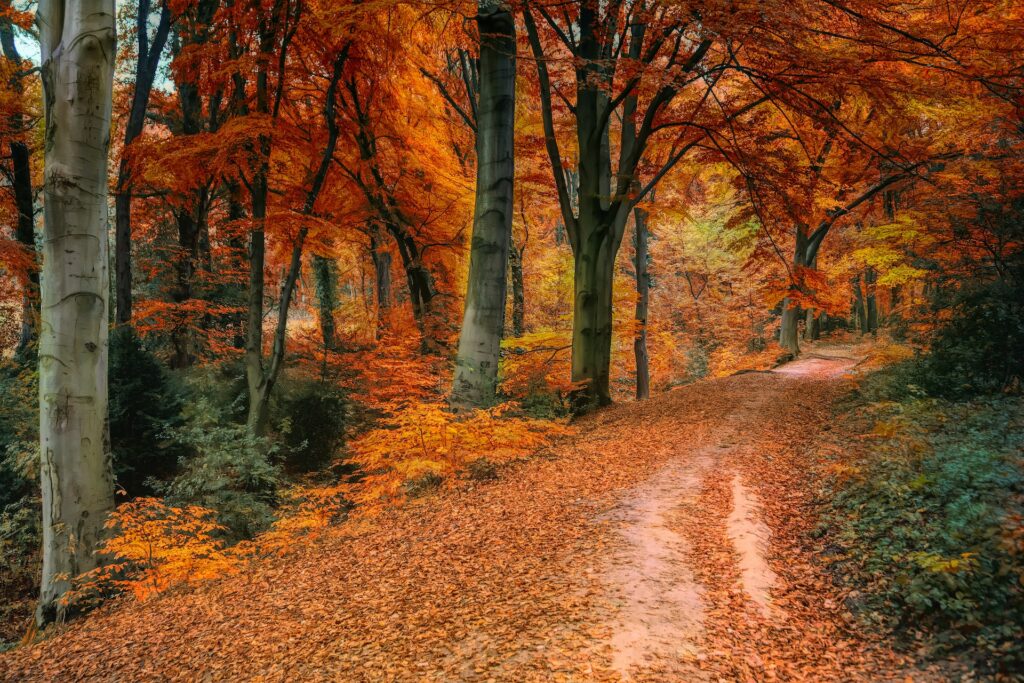
When photographing fall foliage, the right location can make all the difference. Nature provides a stunning canvas of colors during autumn, and your task is to find the perfect backdrop to frame the beauty of the changing leaves. In this section, we’ll explore how to discover scenic spots for capturing fall foliage, the art of research and scouting for the ideal location, and the thrill of uncovering lesser-known gems and hidden treasures.
Scenic Spots for Capturing Fall Foliage
The United States and many other parts of the world are blessed with many scenic locations that burst into vibrant color during the fall. Here are some classic spots to consider for capturing the magic of autumn:
1. New England, USA
- Vermont, New Hampshire, and Maine are renowned for their stunning fall foliage. The rolling hills, covered bridges, and quaint villages provide iconic backdrops.
2. The Great Smoky Mountains, USA
- The Great Smoky Mountains National Park, straddling the border of North Carolina and Tennessee, offers diverse elevations and an array of tree species, resulting in a prolonged fall season.
3. The Adirondacks, USA
- Upstate New York’s Adirondack Mountains boast a breathtaking mix of red, orange, and yellow hues against serene lakes and rugged peaks.
4. The Canadian Rockies, Canada
- The Rocky Mountains in Canada, including Banff and Jasper National Parks, offer stunning vistas of colorful forests against a backdrop of towering mountain ranges.
5. The Cotswolds, England
- The charming English countryside becomes a tapestry of red and gold during the autumn months. Picturesque villages and rolling hills create a storybook setting.
6. The Black Forest, Germany
- Germany’s Black Forest, or Schwarzwald, is known for its dense woodlands and charming villages, making it an ideal location for capturing fall foliage.
7. Kyoto, Japan
- The ancient city of Kyoto bursts with color during the fall, with maple trees turning the city into a vivid, fiery spectacle.
Research and Scouting for the Ideal Location
Finding the perfect location for fall foliage photography requires careful research and scouting. Here’s how to go about it:
- Start Early: Begin your research well before the fall season starts. Understand the typical timing of the peak foliage in your chosen location.
- Online Resources: Use websites, forums, and social media to gather information from fellow photographers who have visited the area. They often share tips, the best vantage points, and updated foliage conditions.
- Local Knowledge: Talk to residents, park rangers, or guides who can provide valuable insights on where and when to capture the most vibrant fall colors.
- Maps and Apps: Use maps, apps, or GPS tools to pinpoint specific locations and trails that promise fantastic fall foliage shots.
- Scouting Trips: Consider planning trips in advance to explore potential shooting spots. This will allow you to pre-visualize compositions and decide on the best times for shooting.
Lesser-Known Gems and Hidden Treasures
While the classic fall foliage spots are undeniably stunning, there’s a unique thrill in uncovering lesser-known gems and hidden treasures. These locations may be off the photography tourist’s radar, but they can yield equally impressive results. Some strategies for finding these hidden spots include:
- Local Tips: Engage with locals and ask them about less-visited areas with beautiful fall foliage.
- Off the Beaten Path: Explore less popular hiking trails or scenic byways less crowded than the well-known destinations.
- Explore Your Backyard: Sometimes, the most beautiful fall foliage can be found in your region. Take time to discover the beauty in your immediate surroundings.
- Chase the Light: Seek out locations where the play of light and shadow adds depth and enchantment to your fall foliage photos.
Capturing fall foliage is a combination of art and exploration. By discovering scenic spots, conducting thorough research, and uncovering hidden treasures, you can create a stunning collection of images that celebrate the beauty of autumn in all its vibrant glory. Whether you opt for classic destinations or venture off the beaten path, the magic of fall foliage awaits your creative lens.
Mastering Composition and Framing for Fall Foliage Photography
Capturing the enchanting beauty of fall foliage goes beyond merely pointing your camera at the colorful landscape. To create truly captivating images, you must master the art of composition and framing. In this section, we will explore the rule of thirds and other composition techniques, understand how to create depth and perspective in your fall foliage photos and discover how framing can maximize the impact of your autumn shots.
Rule of Thirds and Other Composition Techniques
The “rule of thirds” is a fundamental composition technique that can transform your fall foliage photos. This rule divides your frame into nine equal parts using two horizontal and two vertical lines. Placing your subject or focal points along these lines or at their intersections often produces a more balanced and visually appealing composition.
But there’s more to composition than just the rule of thirds. Here are some additional techniques to consider:
- Leading Lines: Use natural lines in the landscape—such as a winding trail, a meandering river, or rows of trees—to draw the viewer’s eye into the image.
- Framing: Frame your subject with elements from the surroundings, like overhanging branches or doorways, to add depth and interest to your photos.
- Symmetry and Patterns: Capture the symmetry of reflections on water or the patterns of leaves on a forest floor to create visually pleasing and harmonious compositions.
- Negative Space: Use negative space around your subject to emphasize its significance and create a sense of tranquility in your images.
- Foreground Interest: Include a compelling foreground element to add depth and context to your fall foliage shots. This can be a rock, a fallen log, or a wildflower.
Creating Depth and Perspective in Your Photos
Depth and perspective are crucial elements in fall foliage photography, as they allow you to convey the three-dimensional quality of the scene. Here’s how to achieve them:
- Layering: Include multiple elements in your shot, placing some in the foreground, some in the middle ground, and some in the background. This layering adds depth and dimension to your photos.
- Leading Lines: As mentioned earlier, leading lines can guide the viewer’s eye through the image, creating a sense of depth.
- Scale: Including an object or person in your composition can help provide a sense of scale, highlighting the grandeur of the fall foliage.
- Foreground Blur: A wider aperture (lower f-number) can create a shallow depth of field, making the foreground and background appear blurred, adding a sense of depth.
- Overlapping Elements: Allow some leaves or branches in the foreground to partially obscure elements in the background, creating a sense of depth and natural layering.
Framing the Fall Foliage for Maximum Impact
Framing is a powerful technique that adds interest and draws the viewer’s eye toward your subject. Consider these framing options for your fall foliage photography:
- Natural Frames: Use the natural surroundings—like tree branches, arches, or rock formations—to frame your subject, creating a sense of place and context.
- Man-Made Frames: Incorporate elements such as windows, doorways, or fences to create intriguing frames around your subject.
- Leaves in the Foreground: Let overhanging branches or fallen leaves naturally frame your image, adding depth and context.
- Silhouettes: Capture the silhouette of a person or object against the colorful backdrop of fall foliage, creating a powerful frame for your subject.
- Diagonal Frames: Experiment with diagonal lines and shapes within the frame to add dynamism and a sense of movement to your compositions.
The key to mastering composition and framing for fall foliage photography is to experiment and fine-tune your approach. The fall season offers a wealth of opportunities to hone your skills, and each new shot is a chance to create a stunning visual masterpiece that encapsulates the enchantment of autumn.
Chasing the Perfect Light for Fall Foliage Photography
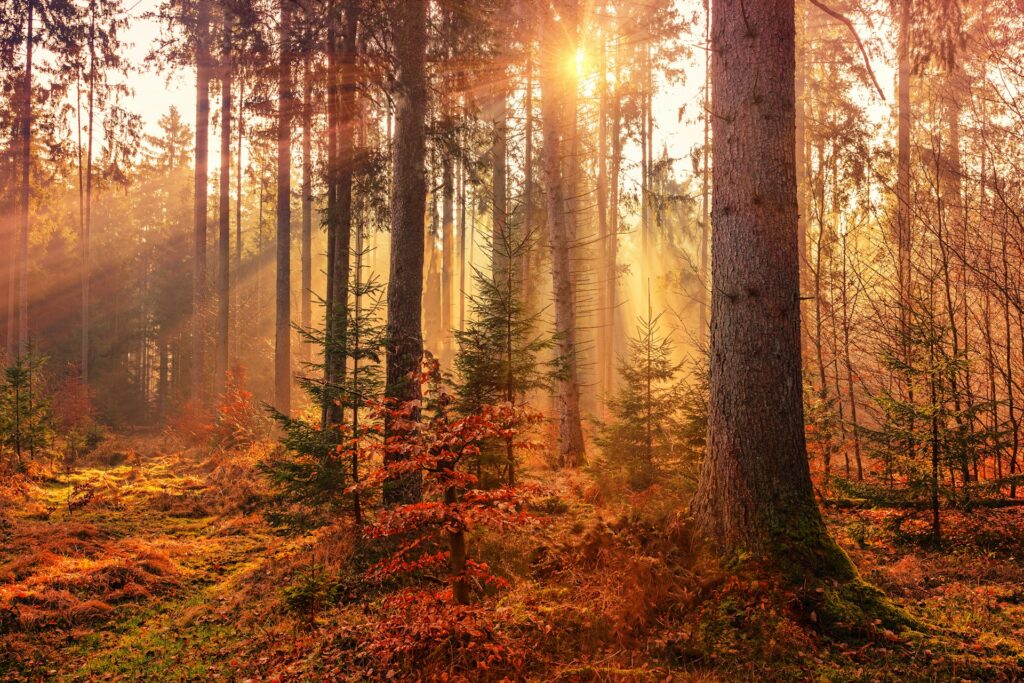
Capturing the mesmerizing beauty of fall foliage requires more than just the right location and equipment. Light is one of the most critical elements that can transform your autumn shots. This section will explore the significance of golden hours, strategies for dealing with overcast days, and techniques for harnessing natural light to create stunning fall foliage images.
Golden Hours and Their Significance
Golden hours, the moments shortly after sunrise and just before sunset, are often called the “magic hours” in photography. During these times, the sun’s angle bathes the landscape in soft, warm, and diffused light, creating a captivating and ethereal atmosphere.
Here’s why golden hours are particularly significant for fall foliage photography:
- Warm, Soft Light: The sun’s low angle during golden hours softens the shadows and imparts a warm, golden glow to everything it touches. This quality of light enhances the vibrant colors of autumn leaves, making them appear even more vivid and enchanting.
- Long Shadows: The directional light during golden hours casts long and dramatic shadows, adding depth and dimension to your fall foliage images. These shadows create interesting textures and patterns on the ground and amidst the leaves.
- Subtle Highlights and Details: The warm, angled light can reveal intricate details and textures in the leaves that might go unnoticed in harsh midday sunlight.
Plan your photography outings during these times to make the most of golden hours. Check sunrise and sunset times for your location, and be prepared to capture the magical interplay of light and fall foliage.
Dealing with Overcast Days
While golden hours offer the most favorable lighting conditions, fall weather can be unpredictable, and overcast days are common. Here are strategies for making the best of cloudy skies:
- Embrace Soft Light: Overcast skies act as a giant diffuser, providing soft, even light that can be ideal for capturing the delicate colors and details of fall foliage. Use these days to focus on close-ups, capturing the subtleties of leaves and textures.
- Avoid Harsh Shadows: Overcast days eliminate strong shadows, making shooting easier throughout the day. This can be advantageous for landscapes and scenes where you want to avoid harsh contrasts.
- Enhance Color Saturation: Cloudy conditions can enhance the saturation of colors, making the fall foliage appear more vibrant in your photos.
- Experiment with Longer Exposures: Cloudy conditions can be conducive to longer exposures, allowing you to create a sense of movement in the leaves or the water while retaining the colors and details.
Techniques for Harnessing Natural Light
The ability to harness and control natural light is a fundamental skill in photography. Here are some techniques to consider when working with natural light for fall foliage photography:
- Backlighting: Position your subject between the camera and the light source (e.g., the sun) to create a stunning, backlit effect. This can highlight the edges of leaves, adding a magical, translucent quality.
- Silhouettes: Use backlighting to create striking silhouettes of subjects against the colorful backdrop of fall foliage.
- Filter Use: Consider polarizing filters to reduce glare and enhance color saturation in your fall foliage images. These filters are particularly effective when the sun is at an angle to the camera.
- Reflectors: Experiment with reflectors to bounce light back onto your subject, softening shadows and illuminating details.
- Artificial Light: In some situations, you may need to introduce artificial light sources, like flashes or diffusers, to control and balance the light in your images.
In fall foliage photography, understanding light and its nuances is essential for creating stunning, evocative images. Whether you’re basking in the warm glow of golden hours, embracing the soft light of overcast days, or experimenting with various techniques, the art of lighting is a vital aspect of capturing the mesmerizing beauty of autumn.
Capturing the Changing Colors of Fall Foliage
The changing colors of fall foliage are a natural spectacle that draws photographers from all corners of the world. Autumn’s transformation, with its stunning shifts from vibrant green to fiery reds, rich oranges, and deep golds, offers a unique opportunity to create a visual narrative of nature’s transformation. In this section, we will delve into the art of capturing the changing colors, understanding the stages of this transformation, considering the role of weather in photography, and creating a visual narrative of the awe-inspiring journey from green to gold.
Understanding the Stages of Color Change
Fall foliage change is a fascinating journey that can vary depending on climate, location, and tree species. While the exact timing and duration of these stages can differ, a general understanding of the process can help you plan your fall foliage photography:
1. Verdant Greens: The season begins with trees clothed in lush, green foliage. This is when the leaves produce chlorophyll, the pigment responsible for their green color.
2. Transitioning Hues: As daylight decreases and temperatures drop, chlorophyll production decreases. This allows other pigments—like carotenes and anthocyanins—to emerge, revealing shades of yellow and orange.
3. Dramatic Reds: In certain tree species, the presence of anthocyanin pigments results in brilliant red and purple leaves. These pigments become more pronounced as the chlorophyll fades.
4. Final Brilliance: Ultimately, the leaves reach their peak of vibrant color, creating a dazzling display before they begin to fall.
The Role of Weather in Photography
Weather plays a pivotal role in fall foliage photography. Here are some weather-related considerations:
- Sunlight: The angle and intensity of sunlight can drastically affect the appearance of fall foliage. Bright, direct sunlight can create harsh contrasts and make colors appear less saturated. Photographing during the golden hours or on overcast days can mitigate these issues.
- Rain can enhance colors by adding a glossy, reflective sheen to leaves. It’s worth considering rain as an opportunity rather than an obstacle.
- Wind: Windy conditions can pose challenges, making capturing sharp images of leaves in motion difficult. However, wind can also creatively convey a sense of movement and life in your photos.
- Fog and Mist: Misty mornings or foggy days can add a touch of mystery and ethereality to your fall foliage shots, creating a soft and dreamy atmosphere.
Creating a Visual Narrative of Transformation
To capture the changing colors of fall foliage in a way that tells a compelling visual story, consider these tips:
- Repeat Visits: Plan multiple visits to the same location to document the evolving colors. Create a series of images that show the progression from green to gold.
- Close-Up Details: Don’t just focus on wide landscapes. Zoom in to capture the intricate details of leaves and the rich textures of the changing foliage.
- Seasonal Companions: Include human or animal subjects in your shots to demonstrate the scale and beauty of the changing landscape.
- Reflections: Incorporate reflections in water bodies to double the impact of the changing colors.
- Capture the Elements: Raindrops, frost, or snow can add an extra layer of visual interest to your fall foliage images, emphasizing the transformation and beauty of the season.
- Day-to-Night: Consider creating images from dawn to dusk, showing how the colors change with the light throughout the day.
Capturing the changing colors of fall foliage requires patience, planning, and a deep appreciation for the beauty of transformation. By understanding the stages of color change, appreciating the role of weather in photography, and creating a visual narrative, you can craft a compelling visual story of nature’s spectacular transition from green to gold.
Creativity in Fall Foliage Photography
Fall foliage photography is not just about capturing the beauty of nature; it’s an opportunity to infuse your images with creativity and unique perspectives. In this section, we’ll explore ways to take your fall foliage photography to the next level by experimenting with angles and perspectives, playing with depth of field, and incorporating unique elements into your shots.
Experimenting with Angles and Perspectives
One of the best ways to make your fall foliage photos stand out is by exploring different angles and perspectives. Here are some ideas to consider:
- Low-Angle Shots: Get down low and capture the colorful leaves from ground level. This can add depth and a unique vantage point to your images.
- Bird’s Eye View: Climb higher vantage points to capture the fall landscape from above. A drone can be a valuable tool for this purpose.
- Close-Ups: Zoom in on individual leaves or clusters of leaves. The intricate details and vibrant colors can create stunning, abstract compositions.
- Wide-Angle Panoramas: Use a wide-angle lens to capture the grandeur of the fall landscape. Sweep your camera from side to side to create panoramic images.
- Shoot Through Elements: Frame your subject with natural elements like branches, leaves, or rocks. This adds depth and context to your shots.
- Reflections: Capture the reflection of fall foliage in a body of water, such as a lake or pond, to create a mirrored, captivating, and creative image.
Playing with Depth of Field
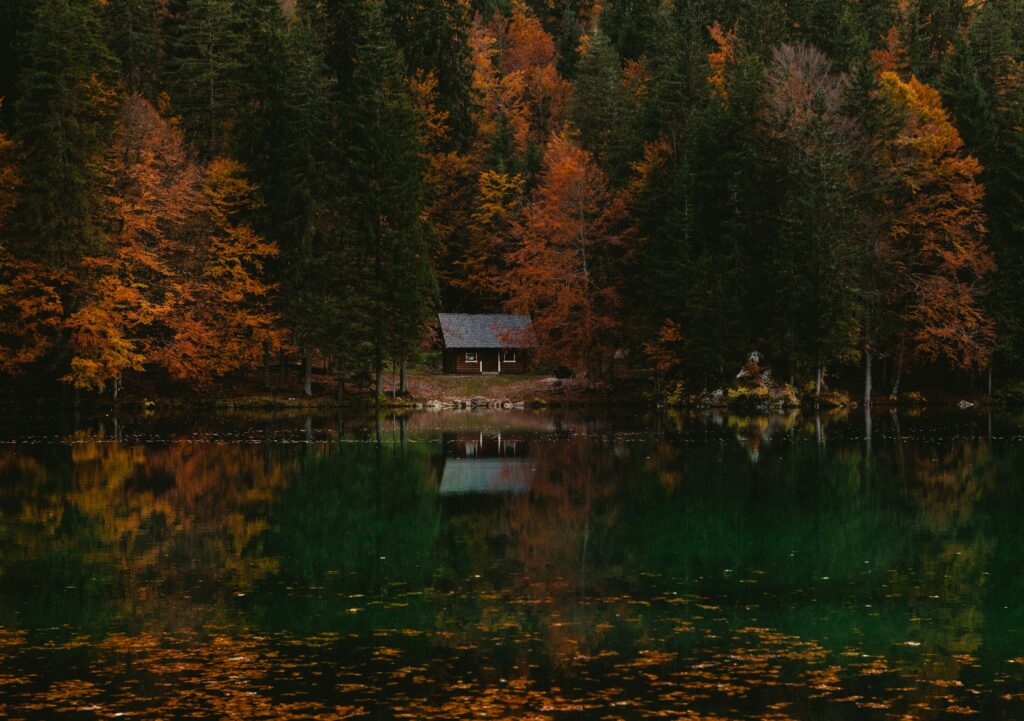
Manipulating the depth of field is another powerful technique for creative fall foliage photography. Here’s how you can use it to your advantage:
- Shallow Depth of Field: Use a wide aperture (small f-number) to create a shallow depth of field, where your subject is in sharp focus while the background becomes beautifully blurred. This technique perfectly isolates individual leaves or subjects against a dreamy, soft backdrop.
- Deep Depth of Field: On the other hand, you can use a narrow aperture (large f-number) to create a deep depth of field, ensuring that the entire scene, from foreground leaves to distant trees, is sharp and clear. This technique can showcase the rich colors and textures of the entire landscape.
- Focus Stacking: If you want everything in your scene to be in sharp focus, consider focus stacking. This advanced technique involves taking multiple shots at different focus distances and blending them in post-processing to create a single image with exceptional depth of field.
Incorporating Unique Elements into Your Shots
Adding unique elements to your fall foliage images can set them apart from the typical autumn photos. Here are some creative ideas:
- Wildlife: Incorporate animals, such as birds or deer, into your shots to add life and a sense of scale to the scene.
- Man-Made Objects: Include elements like rustic fences, old barns, or charming cottages to juxtapose the beauty of nature with human-made structures.
- People: Invite a model to be part of your composition, whether they’re strolling through the leaves, enjoying a picnic, or simply standing in awe of the fall colors.
- Natural Textures: Look for contrasting textures, like rough tree bark against delicate leaves, to add visual interest and depth to your photos.
- Macro Details: Get close to the ground and capture macro details of leaves, moss, or dewdrops to create abstract and visually compelling images.
- Creative Filters: Experiment with creative filters, such as starburst filters, to add unique and magical effects to your photos.
Fall foliage photography offers a canvas of colors and textures perfect for unleashing creativity. By experimenting with angles and perspectives, playing with depth of field, and incorporating unique elements, you can produce beautiful fall foliage images and uniquely your own.
Post-Processing and Editing Tips for Fall Foliage Photography
The journey of fall foliage photography doesn’t end when you capture the image; it continues in the digital darkroom. Post-processing and editing are essential steps in enhancing the beauty of your fall foliage photos. In this section, we’ll explore the key aspects of post-processing, including choosing the right editing software, enhancing fall colors in post-production, and retaining the authenticity of your photos.
Choosing the Right Editing Software
Selecting the right editing software is the foundation of successful post-processing. Here are a few popular choices for photographers:
- Adobe Lightroom: Lightroom is a versatile and user-friendly choice, perfect for organizing and enhancing your images. It provides various editing tools, including color adjustments, tone control, and local adjustments.
- Adobe Photoshop: Photoshop is the industry standard for more advanced editing and retouching. It’s great for fine-tuning specific aspects of your images.
- Capture One: Capture One is known for its excellent color grading tools and capacity to bring out the best in RAW files.
- Luminar: Luminar offers an array of creative filters and AI-powered tools for enhancing images, making it a fantastic choice for those who want to experiment with their fall foliage shots.
- GIMP: If you’re looking for a free option, GIMP (GNU Image Manipulation Program) is a powerful open-source software with many features in premium editing programs.
Enhancing Fall Colors in Post-Production
Post-processing allows you to take the already vibrant colors of fall foliage and make them pop even more. Here’s how to enhance those hues effectively:
- Saturation and Vibrance: Use the saturation and vibrance sliders to boost the intensity of the fall colors. Be cautious not to overdo it; subtle adjustments often yield the best results.
- Color Balance: Adjust the color balance to fine-tune the warmth or coolness of your image. Warmer tones can enhance the autumnal feeling, while cooler tones can add a unique twist to your shots.
- Contrast and Clarity: Increasing contrast and clarity can make your fall foliage pop. This is particularly effective for enhancing textures and details in the leaves.
- HSL (Hue, Saturation, and Luminance): HSL adjustments allow you to fine-tune individual colors. This makes specific hues, like reds and oranges, more vibrant while preserving the overall image.
- Graduated Filters: Use graduated filters to enhance the colors of the sky and the landscape selectively. Graduated filters can add drama to your shots without impacting the entire image.
- Dodge and Burn: Dodge and burn tools help to highlight specific areas of your photo, like the brightest parts of leaves or the colors of a sunset.
Retaining the Authenticity of Your Photos
While enhancing fall colors is part of the post-processing process, it’s crucial to maintain the authenticity of your images. Here are some tips to ensure your fall foliage photos remain genuine:
- Avoid Over-Editing: It’s easy to get carried away with adjustments, but remember that subtlety often yields more natural results.
- Maintain Realistic Colors: While you can enhance colors, try to ensure they remain within reality. Extreme color manipulation can make your photos appear unnatural.
- Preserve Details: Remember to maintain important details in pursuing perfect colors. Keep an eye on highlights and shadows to maintain texture and depth.
- Respect the Scene: Remember that your fall foliage photos reflect a specific moment. Try to retain the mood, atmosphere, and character of the scene you captured.
- Backup Your Originals: Always keep the original, unedited files. This allows you to revisit and reprocess your images later if your editing skills improve or you want to try a different approach.
Post-processing and editing are powerful tools for enhancing your fall foliage photography. Still, they should be used thoughtfully to enhance the season’s natural beauty rather than alter it beyond recognition. By choosing the right editing software, enhancing fall colors effectively, and preserving the authenticity of your photos, you can produce images that vividly capture the splendor of autumn.
Challenges and Solutions in Fall Foliage Photography
Fall foliage photography is a breathtaking and rewarding endeavor, but like any photographic genre, it has its unique challenges. This section explores these challenges and provides practical solutions for dealing with unexpected weather conditions, avoiding common pitfalls in fall foliage photography, and capturing vibrant colors even on cloudy days.
Dealing with Unexpected Weather Conditions
Challenge: Fall weather can be unpredictable. Sunny days can turn cloudy, and rain or wind might disrupt your plans. Sudden weather changes can be a significant challenge for fall foliage photography.
Solution:
- Plan Ahead: Keep a close eye on weather forecasts. Plan your photography outings around days with favorable weather conditions. However, let less-than-perfect forecasts deter you; sometimes, dramatic skies can add a unique dimension to your images.
- Embrace Overcast Days: Overcast conditions can provide soft, diffused light, making them ideal for capturing the rich colors of fall foliage without harsh shadows. Use this to your advantage, and consider incorporating reflections in water for added interest.
- Rain Protection: Invest in rain covers for your camera and equipment. A drizzle or light rain can enhance the colors of leaves, creating beautiful, glossy surfaces. Just be prepared to keep your gear dry.
- Wind Control: Wind can be problematic, especially when shooting macro or detailed images. Use windbreaks like large reflectors or a makeshift windbreak to shield your subject from gusts.
- Patience: Sometimes, the best shots are captured by waiting out adverse weather conditions. The weather might change, offering an opportunity for unique shots, such as raindrops on leaves or misty landscapes.
Avoiding Common Pitfalls in Fall Foliage Photography
Challenge: Common pitfalls in fall foliage photography can include cliche compositions, cluttered images, and overprocessing.
Solution:
- Composition: Experiment with angles, perspectives, and framing. Avoid overly symmetrical or centered compositions. Choose elements that complement and enhance the scene rather than cluttering it.
- Timing: The fall foliage season is relatively short, and planning your visits for peak color is essential. Aim to be in the right place at the right time to capture the most vibrant colors.
- Depth: Ensure that your images have depth and visual interest. Incorporate foreground elements to create a sense of scale and add context to the scene.
- Overediting: While post-processing is vital, it’s easy to go overboard. Maintain a balance between enhancing colors and preserving the authenticity of your photos. Subtlety often results in more appealing images.
- Patience: Avoid rushing through the process. Take time to compose your shots, wait for the right light, and capture the season’s essence.
Tips for Capturing Vibrant Colors on Cloudy Days
Challenge: Cloudy days can make capturing the vibrancy and brilliance of fall colors challenging.
Solution:
- Use Filters: Polarizing filters can reduce glare and enhance color saturation. These filters are particularly effective when the sun is at an angle to the camera, which is common on cloudy days.
- Add a Pop of Color: Incorporate a pop of color into your composition, such as brightly colored clothing, accessories, or objects. This can provide contrast and make your images more visually appealing.
- Post-Processing: In post-processing, use software to enhance colors and contrast. Adjusting the saturation and vibrance can help bring out the vibrant hues that might be subdued under cloudy skies.
- Embrace Overcast Conditions: Overcast days have their unique charm. Use the soft, even light to your advantage, especially for close-ups and detailed shots of leaves.
- Fill Flash: If you have access to an external flash, consider using fill flash to add some extra light to your subject. This can help lift colors and details, even on cloudy days.
Fall foliage photography is a thrilling adventure, and its challenges are part of what makes it so exciting. By planning, embracing changing weather conditions, avoiding common pitfalls, and using creative techniques, you can overcome these challenges and capture autumn’s vibrant and captivating colors, even on cloudy days.
The Joy of Sharing Your Autumn Story
The autumn season, with its splendid colors and enchanting landscapes, offers a captivating narrative for photographers. It’s a time when nature undergoes a stunning transformation, and capturing this metamorphosis through fall foliage photography can be a rewarding experience. However, the joy doesn’t end with taking the perfect shot. Sharing your autumn story can be just as gratifying. In this section, we’ll explore the joy of sharing your fall foliage journey, discussing social media platforms for showcasing your work, building a community of fellow autumn enthusiasts, and the impact of sharing your autumn narrative.
Social Media Platforms for Showcasing Your Work
Social media has become a powerhouse for photographers to exhibit their craft. When it comes to sharing your fall foliage journey, consider these platforms:
- Instagram: Instagram is the quintessential platform for visual storytelling. Use it to create a curated feed of your best fall foliage images, engage with your audience through hashtags, and connect with fellow photographers.
- Facebook: Facebook allows for more extended narratives. Share albums and stories about your autumn experiences, and join photography groups or communities to connect with like-minded individuals.
- Flickr: Flickr is a platform designed specifically for photographers. It’s an excellent place to showcase your fall foliage albums, gain feedback from a photography-centric audience, and explore other photographers’ work.
- 500px: 500px is a community of photographers who appreciate high-quality imagery. It’s an ideal platform to display your best fall foliage shots and connect with a dedicated audience.
- Pinterest: Pinterest is a visual discovery and bookmarking platform. Share your fall foliage images, and they may become a source of inspiration for others planning their autumn adventures.
Building a Community of Fellow Autumn Enthusiasts
The joy of sharing your fall foliage journey is magnified when you connect with a community of fellow autumn enthusiasts. Here’s how you can build and engage with this community:
- Join Photography Groups: Look for photography groups on social media platforms like Facebook or specialized forums. These groups often organize contests, share tips, and provide valuable feedback.
- Collaborate: Consider collaborating with other photographers for photo walks or projects focused on fall foliage. Collaboration can lead to fresh perspectives and shared insights.
- Attend Workshops and Conferences: Participate in photography workshops or conferences related to fall foliage. These events are excellent opportunities to network and learn from experienced photographers.
- Participate in Challenges: Many photography groups and platforms host themed challenges or contests. Participating can be an excellent way to challenge your skills and gain recognition.
- Offer Guidance: Share your knowledge and expertise with others, whether through blog posts, video tutorials, or mentoring. Being an active contributor to the community can be immensely rewarding.
The Impact of Sharing Your Autumn Narrative
Sharing your fall foliage journey goes beyond mere likes and comments. It can have a profound impact:
- Inspiration: Your images may inspire others to explore and appreciate the beauty of autumn. Your narratives can ignite a sense of wanderlust and curiosity.
- Connection: Sharing your journey can connect you with people who share your passion. You may find lifelong friends and fellow adventurers through your shared love for autumn.
- Learning and Growth: Engaging with others in the photography community can offer new perspectives and knowledge. The feedback you receive can help you grow as a photographer.
- Awareness: Your work can contribute to the conservation and appreciation of nature. By showcasing the beauty of fall foliage, you can raise awareness about the importance of preserving these environments.
- Memories: Sharing your journey allows you to document your experiences and create a visual diary of your adventures during the autumn season.
The joy of sharing your fall foliage journey extends beyond photography. It’s about connecting with others, inspiring them, learning, growing, and leaving a lasting impact. As you continue to capture the breathtaking colors of autumn, consider sharing your narrative and inviting others to embark on this incredible journey with you.
Ultimately, capturing the mesmerizing beauty of fall foliage isn’t just about taking pictures; it’s a journey of connecting with nature, immersing yourself in the breathtaking transformations of the season, and sharing your experiences with others. Autumn is a time of vibrant colors, unique challenges, and boundless opportunities for creativity, and your camera is your passport to this magical world.
As you embark on your fall foliage photography adventures, remember to be patient with the ever-changing weather, approach your compositions with a keen eye for detail, and use post-processing techniques that enhance but don’t overshadow the authenticity of your photos. The joy of sharing your autumn story is an integral part of this journey as you bring the season’s beauty to a broader audience and connect with fellow enthusiasts who share your passion.
Through the lens of your camera, you not only capture the breathtaking colors but also the emotions, the stories, and the transformations that make autumn a remarkable and cherished season. So, whether you’re sharing your images on social media, building a community of fellow photographers, or inspiring others to appreciate the beauty of fall, know that your efforts have a lasting impact.
The world is waiting to witness the magic of fall through your lens. The vibrant leaves, the crisp air, and the golden light are your canvas, and your camera is the brush that paints the unforgettable autumn scenes. This season, let the joy of fall foliage photography be your guiding light as you explore, create, share, and continue to tell the captivating story of nature’s splendid transformation.

